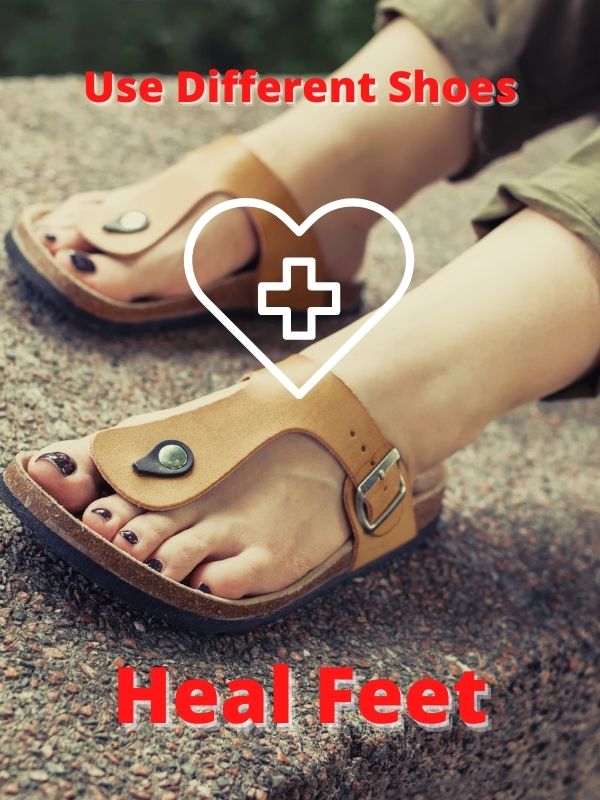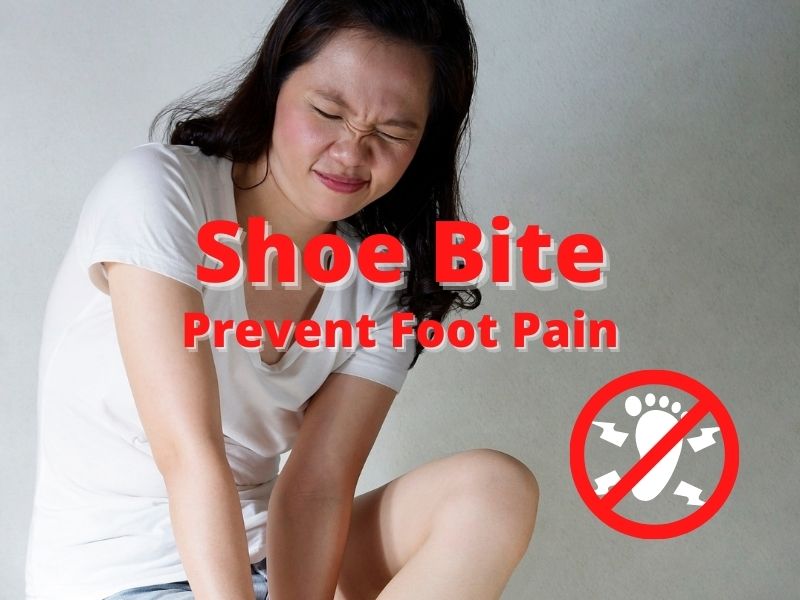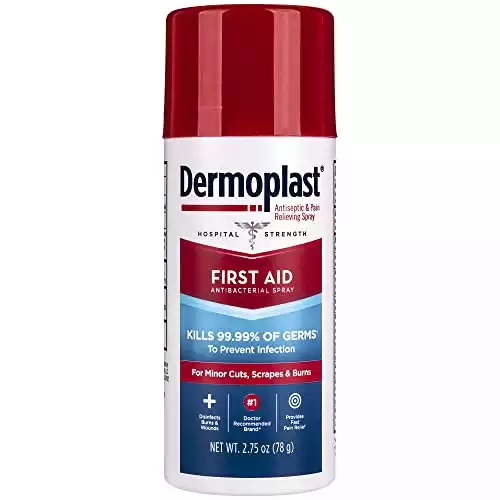If you think that only things with teeth can bite, then you would be sorely mistaken, quite literally. Your shoes have the ability to bite your feet, and although it may not be the typical toothy bite, it still causes pain.
A shoe bite is a raw spot anywhere on the foot resulting from excessive foot rubbing in that area. Shoe bites go from bad to worse rather quickly as a result of unrelenting shoe friction. So, how is it possible to heal when the things meant to protect your feet damage them instead?
The good news about shoe bite is that it is preventable and treatable, and you may even be able to make peace with your shoes after this painful ordeal. Let’s explore the reasoning behind the origin of your shoe bites and the ways in which you can beat them!
Why Are My Shoes Biting Me?

Shoe bites can occur all over the feet because friction can occur anywhere on the feet. Why does friction occur? Chances are, it is because your shoes are too snug.
This is a common complication with new shoes, especially those stylish pairs that are so devastatingly good-looking that the pain almost seems worth it.
This is not to say that you should give up on new shoes. On the contrary, you should actually pay more attention to your new shoes, especially before buying them.
Taking the time to focus on your shoes’ feel over their look can save you a lot of trouble in the long run. It is impossible to know how a show will affect your foot without wearing it, so the first step is trying on any shoe you are interested in.
It can be difficult to notice pressure points within a new shoe, so a short walk about the store should tip you off to any uncomfortable rubbing. Even the slightest sensation of discomfort can manifest into shoe bites after a day of walking, so seriously consider any rubbing as a possibility for future shoe bites.
(USEFUL IDEAS FOR HIGH HEELS)
Some of the most common areas to develop shoe bites are on the back of the heel, where the base of the Achilles tendon can be felt, on the toes, and near the lip of any shoe.
Bites on the heel and top of the foot near the lip of the shoe are generally a direct result of the friction of the shoe, but bites on the toes can be a result of toe-on-toe friction. For this reason, it is important to consider how the front and back of every shoe fits.
There is also a possibility that your shoes are biting you as a result of them being too loose in some places. Shoes that have loose heels but fit the rest of the foot well will flop up and down in the back with every step. This exaggerated and repeated motion on the heel can result in large, raw patches of painful skin.
The key to choosing the right shoes is ensuring that they fit comfortably without being too loose, too snug, or having any major rubbing points. So what about the biting shoes you already own and the ones you know will bite but are so charming you just can’t say no?
Don’t worry, you won’t have to give them up. Just like a nippy dog, your shoes can be trained to treat you well. It only requires a little time, effort, and know-how.
How Can I Stop My Shoes From Biting?

Luckily, there are a few different methods you can use to stop your shoes from leaving those nasty bites, so you can choose the one that best fits you and your kicks.
1. Stretch Your Shoes
Shoe stretching has been a method of achieving the perfect fit since the early days of cobbling. Modern times and a variety of preset shoe sizes have made shoe stretching a less common occurrence, but you can still reap its benefits without even leaving your home!
If you have numerous shoes that require stretching, then it may be worth investing in a plastic or wooden shoe shaper/stretcher that can be extended and expanded. If you are trying to make do with one pesky pair of shoes, then you can attempt to create your own mold out of household items.
A series of small yet firm items that can be stuffed into your shoes for a snug fit will work perfectly. In some cases, firmly forcing bunched fabric into shoes can also work to stretch them, but be sure to fill both shoes evenly to avoid lopsided results.
After your shoes are stuffed or molded, they can be left overnight to stretch to a more comfortable size. Adding a blast of heat from a hairdryer or heater can emphasize the results of your shoe stretching, but this often depends on the materials your shoes are made out of.
Leather, faux leather, polymer mixes, and some fabrics respond well to this method. It is important to remember that this method can solve shoe bites when shoes are slightly too tight; however, extremely tight or loose shoes are unlikely to benefit from being stretched.
2. Oil Your Shoes
Shoes made of leather or other leather materials can benefit from the addition of oil. Oil provides these materials with hydration and lubrication to help soften them.
When applied to areas where you are experiencing abrasion, oil can reduce the friction between your foot and the shoe and loosen the material for a more comfortable fit.
This method can be practiced by rubbing clean shoes with body-safe oils, like coconut oil, olive oil, and others. Spot-testing your shoes with these oils before applying them over the entire shoe is a good way to ensure that the material is not stained or damaged by the addition of oil.
It is also important to treat any pre-existing shoe bite wounds before allowing your oil-treated shoes to rub against your feet again.
3. Wet Your Shoes
This may sound counter-intuitive, but wetting and drying your shoes can actually help them better fit your feet! This option is best suited for shoes that are not water-sensitive and have a fairly open design, such as sandals.
First, you wet your shoes in warm water, and then you wear them until they dry. Doing this may be a bit uncomfortable at the start, but as your shoes dry, you will notice that they have stretched and fit much more comfortably.
There is always the chance that wearing wet shoes for too long can cause damage to the skin of your feet, so if your shoes do not dry within an hour, it may be best to put a mold in them (as explained in the Stretch em’ Out section) to allow for completion of the drying process.
How Do I Heal My Shoe Bites?

If you have preexisting shoe bites, then you will need to heal them before you start to enjoy your newly stretched and refitted shoes. Healing wounds on the feet can be a challenging process. Constant use and flexing often reopen wounds and delay healing.
To avoid this complication and heal faster, it is recommended that you wear shoes that do not touch the area where your shoe bit is located. For example, wear sandals if you have a shoe bite on the back of your heel so it receives air and avoids any friction.
Once you have found a pair of shoes that protects your shoe bite, you can move on to treating it. Some people recommend natural remedies such as honey, aloe Vera, and petroleum jelly.
However, you are free to use anything that relieves your pain and prevents infection, such as antibiotic creams. Ice is a wonderful way to dull the pain of shoe bites, and an anesthetic spray (Amazon Link) can help improve your comfort as well.
If a shoe bite is starting or you expect one to start in any specific area, there are rapid preventative measures that can be taken as well. These include keeping a band-aid or patch of moleskin (the brand of felt skin adhesive) on hand to cover abrasive areas and protect your skin.
Socks are another simple way to reduce shoe abrasion, and the thicker the sock, the less friction you will feel, but not every shoe is meant to be worn with socks.
Shoe bites are a nuisance and they threaten to ruin your relationship with the shoes you love, but their damage does not have to dictate what shoes you wear.
Through careful selection, alteration methods, and healing precautions, you can reclaim long walks in any shoe without the pain of shoe bites. Follow these tips and tricks to beat shoe bite, and your feet will thank you!
Thanks for visiting Helpshoe.com
References:
https://www.healthline.com/health/shoe-bites#treatment
https://www.bebeautiful.in/all-things-skin/skin-concerns/6ways-you-can-treat-shoe-bites-at-home
https://www.skineasi.com/blogs/skincare/everything-you-wanted-to-know-about-shoe-bites


